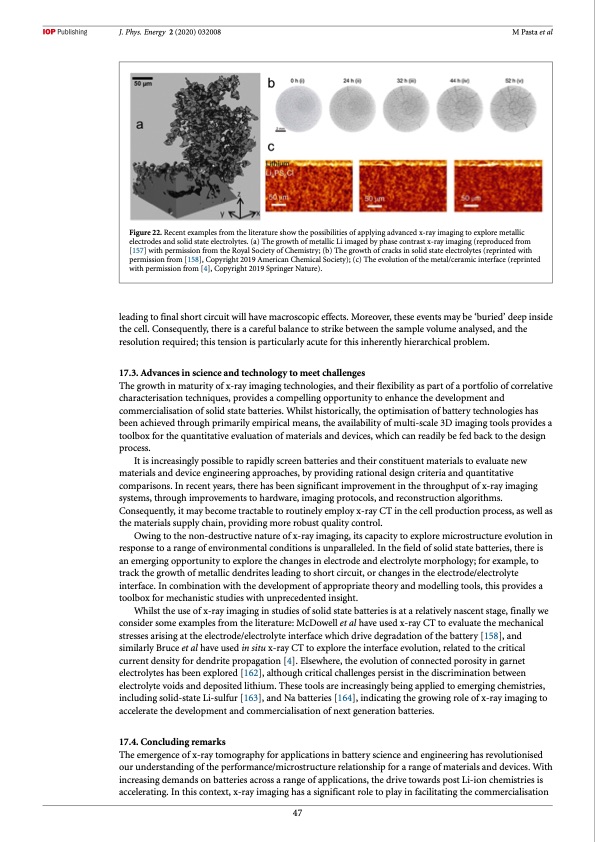
PDF Publication Title:
Text from PDF Page: 048
J. Phys. Energy 2 (2020) 032008 M Pasta et al Figure 22. Recent examples from the literature show the possibilities of applying advanced x-ray imaging to explore metallic electrodes and solid state electrolytes. (a) The growth of metallic Li imaged by phase contrast x-ray imaging (reproduced from [157] with permission from the Royal Society of Chemistry; (b) The growth of cracks in solid state electrolytes (reprinted with permission from [158], Copyright 2019 American Chemical Society); (c) The evolution of the metal/ceramic interface (reprinted with permission from [4], Copyright 2019 Springer Nature). leading to final short circuit will have macroscopic effects. Moreover, these events may be ‘buried’ deep inside the cell. Consequently, there is a careful balance to strike between the sample volume analysed, and the resolution required; this tension is particularly acute for this inherently hierarchical problem. 17.3. Advances in science and technology to meet challenges The growth in maturity of x-ray imaging technologies, and their flexibility as part of a portfolio of correlative characterisation techniques, provides a compelling opportunity to enhance the development and commercialisation of solid state batteries. Whilst historically, the optimisation of battery technologies has been achieved through primarily empirical means, the availability of multi-scale 3D imaging tools provides a toolbox for the quantitative evaluation of materials and devices, which can readily be fed back to the design process. It is increasingly possible to rapidly screen batteries and their constituent materials to evaluate new materials and device engineering approaches, by providing rational design criteria and quantitative comparisons. In recent years, there has been significant improvement in the throughput of x-ray imaging systems, through improvements to hardware, imaging protocols, and reconstruction algorithms. Consequently, it may become tractable to routinely employ x-ray CT in the cell production process, as well as the materials supply chain, providing more robust quality control. Owing to the non-destructive nature of x-ray imaging, its capacity to explore microstructure evolution in response to a range of environmental conditions is unparalleled. In the field of solid state batteries, there is an emerging opportunity to explore the changes in electrode and electrolyte morphology; for example, to track the growth of metallic dendrites leading to short circuit, or changes in the electrode/electrolyte interface. In combination with the development of appropriate theory and modelling tools, this provides a toolbox for mechanistic studies with unprecedented insight. Whilst the use of x-ray imaging in studies of solid state batteries is at a relatively nascent stage, finally we consider some examples from the literature: McDowell et al have used x-ray CT to evaluate the mechanical stresses arising at the electrode/electrolyte interface which drive degradation of the battery [158], and similarly Bruce et al have used in situ x-ray CT to explore the interface evolution, related to the critical current density for dendrite propagation [4]. Elsewhere, the evolution of connected porosity in garnet electrolytes has been explored [162], although critical challenges persist in the discrimination between electrolyte voids and deposited lithium. These tools are increasingly being applied to emerging chemistries, including solid-state Li-sulfur [163], and Na batteries [164], indicating the growing role of x-ray imaging to accelerate the development and commercialisation of next generation batteries. 17.4. Concluding remarks The emergence of x-ray tomography for applications in battery science and engineering has revolutionised our understanding of the performance/microstructure relationship for a range of materials and devices. With increasing demands on batteries across a range of applications, the drive towards post Li-ion chemistries is accelerating. In this context, x-ray imaging has a significant role to play in facilitating the commercialisation 47PDF Image | 2020 roadmap on solid-state batteries

PDF Search Title:
2020 roadmap on solid-state batteriesOriginal File Name Searched:
Pasta_2020_J_Phys_Energy_2_032008.pdfDIY PDF Search: Google It | Yahoo | Bing
Sulfur Deposition on Carbon Nanofibers using Supercritical CO2 Sulfur Deposition on Carbon Nanofibers using Supercritical CO2. Gamma sulfur also known as mother of pearl sulfur and nacreous sulfur... More Info
CO2 Organic Rankine Cycle Experimenter Platform The supercritical CO2 phase change system is both a heat pump and organic rankine cycle which can be used for those purposes and as a supercritical extractor for advanced subcritical and supercritical extraction technology. Uses include producing nanoparticles, precious metal CO2 extraction, lithium battery recycling, and other applications... More Info
| CONTACT TEL: 608-238-6001 Email: greg@infinityturbine.com | RSS | AMP |